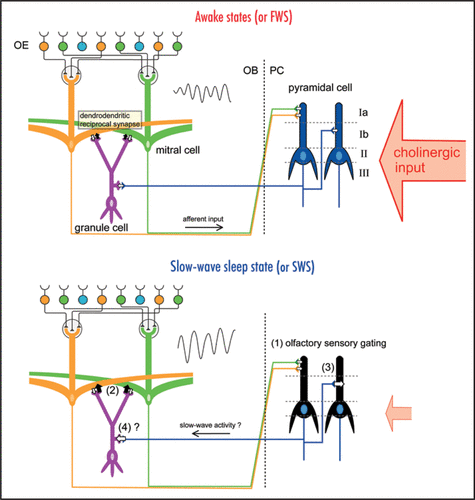Figures & data
Figure 1 Behavioral state-dependent change in information flow in the olfactory system. Schematic diagrams of the neuronal circuit of the olfactory system. The odor information is detected by the olfactory sensory neurons in the olfactory epithelium (OE). Mitral cells in the olfactory bulb (OB) receive excitatory synaptic input from the olfactory sensory neurons and send their axons to the olfactory cortex, including the piriform cortex (PC). The afferent axons from mitral cells of the OB terminate on the dendrites of the pyramidal cells of the PC within layer Ia, whereas the associational fibers from the olfactory cortex terminate in layer Ib or layer III. During awake states or the fast-wave state (FWS) in urethane-anesthetized animals (upper diagram), cholinergic input from the basal forebrain is strong. During the slow-wave sleep state or slow-wave state (SWS) in urethaneanesthetized animals (lower diagram), cholinergic input is weak. During the slow-wave sleep state, (1) olfactory sensory gating occurs in the olfactory cortex, (2) granule-to-mitral dendrodendritic synaptic inhibition is enhanced in the OB and the frequency of gamma oscillation of local field potential (sinusoidal waves, inset) in the OB decreases, (3) the associational input to the PC is enhanced, and (4) the centrifugal input from the PC to the OB granule cells might be enhanced. These state-dependent changes occur coordinately in the whole brain to keep the neuronal circuits functioning optimally in each behavioral state.
